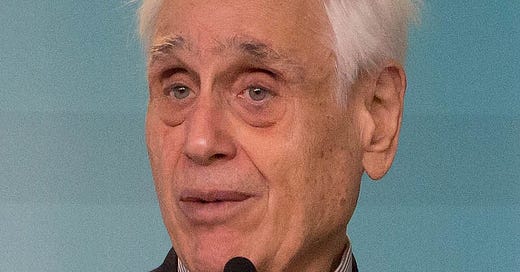Edward Jay Epstein dies
Journalist gave the world the view from inside Angleton's CIA counterintelligence staff
Edward Jay Epstein in 2017 (New America, CC BY 2.0).
The Washington Post reports that the investigative journalist Edward Jay Epstein died on 9 January.
Mr. Epstein probed topics as varied as the 1963 assassination of President John F. Kennedy, U.S. intelligence and counterintelligence, the international diamond trade, the business of Hollywood and the data leak in 2013 by National Security Agency contractor Edward Snowden revealing a massive domestic surveillance program (article unlocked).1
One element missing from the Post’s obituary is Epstein’s relationship with the CIA’s James Angleton, the ultimate source of many of those intelligence stories. A good account of that aspect of Epstein’s career can be found in Of Moles and Molehunters, a 1993 essay by another CIA officer, Cleveland Cram.
After Angleton was fired as chief of the CIA counterintelligence staff in 1974, Cram was appointed to investigate his tenure. As he did so, Angleton and his supporters fought their corner through calculated leaks to journalists like Epstein.
‘A counterattack was planned against the Agency, in particular the new Cl Staff. His objective was to prove how wrong its assessment of Soviet operations was and to indict his successors for negligence of duty.
In this period, Angleton, while not neglecting the possibility of KGB penetration, stressed his belief that the main threat came from KGB deception and disinformation. To support his thesis, he continually cited evidence that [Defector Anatoly] Golitsyn had provided. Angleton’s ideas, propounded by Epstein and other writers, caught fire and created a virtual cottage industry of academic and think tank specialists on the issues he raised.2
Although there had been leaks and whistleblowers before, Epstein’s book Legend: The Secret World of Lee Harvey Oswald was unprecedented in the level of information it provided about the CIA’s Soviet counterintelligence operations. Although Epstein admitted to contacts with Angleton, he did not initially acknowledge him as the source.
Epstein’s Deception: The Invisible War Between the KGB and the CIA was published in 1988, a year after Angleton’s death. Like Legend, its predecessor, it has two parts. The second part describes various deceptions practiced through the centuries and can be ignored; it nothing new. The first says 105 pages, however, are interesting. Therein Epstein repeats the old theories about [defector Yuri] Nosenko and, in his acknowledgments, names all his sources for the past years, including Angleton, [Pete] Bagley, [Newton] Miler, and the FBI’s William Sullivan.3
Cram concluded that with the advent of Glasnost in the Soviet Union, Epstein ‘apparently sensed that the days of the conspiracists were numbered. It was time to take the money and run.’4
In some ways, this verdict from the post-Cold War 1990s has proved too optimistic. In much of the mainstream literature of intelligence, Cram’s judgement of Angleton’s conspiracism has endured. Yet within a decade, very similar ideas about deception were informing the campaign for war with Iraq, a movement which owed something to the ‘cottage industry’ Cram described. One such connection is through the Consortium for the Study of Intelligence, whose colloquia Epstein and many of his ex-CIA sources attended.
That is one reason why, despite their flaws, Epstein’s books on intelligence are important historical documents.
Emily Langer, Edward Jay Epstein, investigative journalist and skeptic, dies at 88, Washington Post, 12 January 2024.
Cleveland C. Cram, Of Moles and Molehunters, Center for the Study of Intelligence, October 1993, p.130.
Cram, op. cit., p.132.
Ibid.





In many ways, “neoconservatives” are really “Angletonians.” If they succeed in getting America into another war through the kind of deception used for Vietnam and Iraq, we’ll know they’re still in power.
Cram hated Angleton for his pursuing the KGB-manipulated James Bennett "mole" case when he was COS in Ottawa.